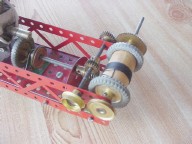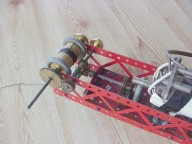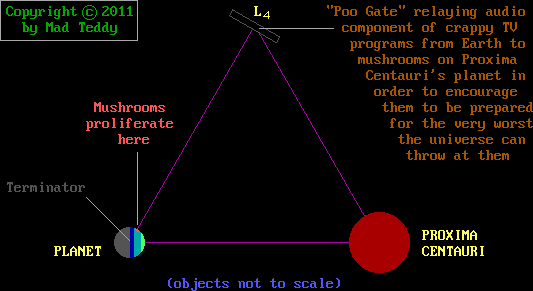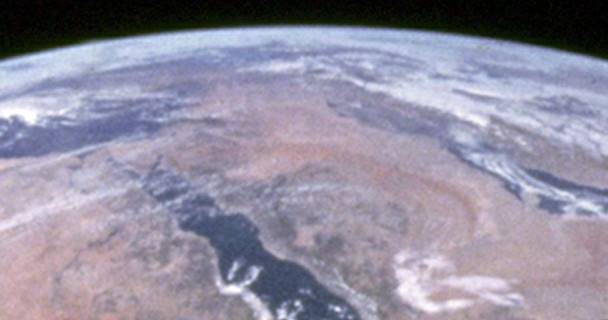
This page composed during December 2010,
I've tried every trick I can think of to remove the flicker, so far without
success (any
suggestions?).
As far as the "jitteriness" is concerned, I suspect that it's very
difficult to do better and still keep the file size down to a quite
reasonable half a megabyte!
If you're a science-fiction fan, as I am, you'll probably realize that this
is an attempt to depict the derelict spaceship Discovery spinning
out of control at the
Lagrange point
between Jupiter and its closest major satellite,
Io
(which is sometimes referred to as the "Pizza Planet", for obvious
reasons.) I used a public-domain NASA photograph of Io, which I found
here,
as the backdrop for the animation.
It's a scene from Arthur C. Clarke's 1982 novel
2010: Odyssey Two.
[If you'd like to see a far more impressive attempt to capture the
"atmosphere" of this scene, click
here
to view a YouTube video which does it beautifully. Here's a little
exercise for you: see if you can spot a fundamental difference between that
version and my own, above (other than the obvious one of quality, or the
fact that my version of Discovery probably spins a bit too fast) -
and then get hold of a copy of the 1984 film to check which version, if
either, is "right"! Here's a clue: it has something to do with
chirality.]
In the "2010" story, an attempt is made to recover the old spaceship -
which had been sent in the general direction of Jupiter back in 2001, as
detailed in Clarke's earlier (1968) epic tale
2001: A Space Odyssey.
Actually, it's not quite that simple. The film version of "2001" indeed
had the action occurring in the vicinity of Jupiter, whereas Clarke's novel
used Saturn as the setting! The reason for the change in the film was that
it was considered too difficult to produce convincing graphics of Saturn's
rings. (It's also worth noting that there were some minor discrepancies in
plot detail between the book and film versions of "2010".) Click on the
above links to read more.
Actually, I'm rather pleased that Jupiter was used in the films (both of
them), because I find the distinctly "yucky" appearance of Io rather
appealing - and if they'd gone to Saturn instead, we'd have missed out on
seeing that, wouldn't we?!
Is it possible that you don't know the basic plots of these stories? In
case you don't, here's a very brief synopsis:
- - - - - - - - - -
In "2001: A Space Odyssey", an exploratory expedition on (Earth's) moon
discovers a "magnetic anomaly" buried near the Tycho crater. It becomes
known as
"TMA-1".
When it is dug up, it turns out to be a black rectangular prism (or
monolith) whose dimensions are in the ratio 1:4:9. The first time
sunlight impinges on it after its long incarceration, it emits a powerful
blast of radio waves, in (as alluded to above) the general direction of
Jupiter.
The crew of Discovery consists of five men and a highly intelligent
computer. Three of the humans are in hibernation for the outward voyage;
the other two (Frank Poole and Commander David Bowman) will, if all goes
well, wake the other three up when they reach Jupiter to conduct a
scientific investigation into whatever they may find there.
It transpires that, in the interests of secrecy, knowledge of the true
nature of the voyage - the possibility of finding extraterrestrial life -
has been entrusted only to the ship's computer, HAL. The plan is that when
the three hibernators are revived, they - along with Bowman and Poole -
will be informed of all the details.
The computer, HAL, comes to believe that the five humans cannot be trusted
to carry out the mission successfully. (Apparently, the fact that he has
been instructed to keep a secret from them - involving what he perceives as
a conflict of logic - has had a serious adverse effect on his personality.)
He therefore plans to get rid of them, take over the ship, and complete
the mission himself.
All together now:
“ BLOODY COMPUTERS!!! ”
HAL reports a non-existent fault in the circuitry which controls the
antenna by which the ship communicates with Earth, necessitating an EVA
(extra-vehicular activity) on the part of one of the human crew members
(Poole) to check it out. To cut a long story short, subsequent events
see Poole and the three hibernators dead. Bowman himself only just escapes
with his life, and then proceeds to disable HAL - and it is then that he
discovers the true purpose of the voyage. So now he's very much on his
own, with a big job to do and little hope of ultimate survival.
“ My God - it's
The photograph I used for the background of this image is
- - - - - - - - - -
In "2010: Odyssey Two", a joint Soviet/US crew sets out for Jupiter in a
Russian spaceship, Alexei Leonov. (Note that the Soviet Union still
existed when this story was written!) The intention is to rendezvous with
Discovery and resurrect HAL (very carefully!) in the hope
that they will thus be able to determine what happened some nine years
earlier. Sure enough, they find Discovery "windmilling" (as shown
above) because its artificial gravity centrifuge (or carousel) has ground
to a halt, transferring its rotational energy to the entire ship - and
they also find the 2km-long "Star Gate" monolith (incongruously dubbed
"Big Brother" by some members of the crew) not far away, just as David
Bowman had reported.
They manage to get the old ship back under control and make it more-or-less
fit for human habitation again. HAL's creator, Dr. Chandra, is along for
the ride, and it is his hair-raising task to get HAL back "up to speed".
The hope is that HAL can be re-educated and ultimately trusted to fly the
ship back in the general direction of Earth.
With these matters proceeding satisfactorily, Leonov's crew begin
some careful tests to try to find out what makes the monolith "tick". None
of their attempts meets with any success, however - until, one day, the
monolith briefly appears to fill with stars again, and a bright
something (which, as subsequent events show, is a pure-energy
version of the human who was once David Bowman) comes shooting out of it
and heads at an enormous speed toward Earth. [Nothing general about the
direction this time - highly specific, in fact: Dave visits (and thus
inadvertently spooks out) various Earthlings with whom he was closely
associated in his former life!
This new version of Dave then returns to Jupiter and is able to communicate
with HAL to pass a message to Leonov's crew that they need to get
away from there in a hurry, as something major and quite catastrophic will
occur soon. The monolith vanishes; shortly thereafter, a swarm of millions
of copies of itself appears on Jupiter, apparently "eating" it and in some
way increasing its density to the point where nuclear fusion begins and the
planet turns into a small star. Leonov just manages to escape in the
nick of time to avoid being destroyed by this explosive event.
Discovery is lost, but somehow HAL's essence is rescued and he
becomes another being like the "new-look" David Bowman, with whom he lives
happily ever after.
The reason for turning Jupiter into a star (as communicated to humanity by
Bowman and his new acquaintances, with some help from HAL) is to provide
sufficient warmth for emerging life on Europa, Jupiter's second major
satellite, to have a chance to flourish and take its place alongside other
civilizations in the universe.
The crew of Leonov and the Earth-bound mission controllers are
already aware that there is primitive life on Europa; now, the message
broadcast over and over again by HAL from Discovery before it is
destroyed, makes the matter quite clear:
ALL THESE WORLDS ARE YOURS
- - - - - - - - - -
Well! You might think that all sounds a bit corny, and you may be right -
but the books are fun to read, the films are visually spectacular, and
there is a certain inspiring mystique about it all. It's also worthy of
note that, before he died in 2008, Sir Arthur wrote two more novels
involving Bowman, HAL, and their pure-energy friends -
2061: Odyssey Three
(published 1988), about the return of Halley's Comet; and
3001: The Final Odyssey
(published 1997), in which Frank Poole is rescued and revived, and
Earth has four
space elevators
connected at their tops by a ring of material in
geostationary orbit.
Make a point of viewing both films and reading all four novels - highly
recommended!
You're probably wondering why I've taken the trouble to recall these old
stories and present some of their salient plot points here - other than
the twin facts that (a.) I'm a science fiction fan and (b.) the title of
one of these novels refers to the current year. I hope the reasons will
become clear shortly.
*
*
*
*
*
The question posed at the top of this page, i.e. "Goodbye, 2010 - where to
from here?" can, of course, be answered trivially thus: "2011, duh
- where else?". However, as I hope you'd expect, my intention is to use
that question as a jumping-off point for consideration of the state of the
world in which we find ourselves at the end of the first decade of the
21st century.
After all, we've seen some real drama over this decade. In 2001 (the year
mentioned in the title of the first of these Clarke stories), the 9/11
incident changed everything (or so we're told). In much of the "western"
world, it's been a decade of right-wing neo-conservative politics,
deregulation of financial institutions, wars over resources (I make no
apology for referring to the war in Iraq as the "Oil War"), and -
ultimately - the global financial crisis (now somewhat trivialized by the
popular use of the three-letter abbreviation "GFC"). Not a good way
to begin a new millenium, in my frank estimation!
It was my growing dismay with what I saw as the legacy of the
Keating/Howard era (1992-2007) down here in Australia that prompted me to
get busy and start to create this website in early 2005, ultimately
launching it in early July 2006. (Nearly six years after I began it, it's
still a work in progress!)
So is there anything fresh and new to say? After all, much of what we see
happening around us is very much a case of
"The Beat Goes On";
and thus it can be all too easy to simply repeat oneself if one isn't very
careful.
Well - I hope you'll find that what follows is topical enough to be worth
reading...
2010 has been a nervous year - both here in Australia, and all over the
world. For me personally, it's been quite traumatic, for a number of
reasons - some of which I've mentioned in my earlier pages
... Who Tube ???
and
Charabanc ride.
Right now, I'm in the throes of winding up my company which I'd hoped
might make a respectable living for me from some of my intellectual
property, but which has ended up costing me more in legal and accountancy
fees since its inception three years ago than it has earned for me in
royalties - and I quite simply can't afford to keep paying money for
nothing. So that's a bit of a "downer", if ever there was one.
(To be honest, I'll be quite glad to see the back of 2010 - but
apprehensive about even how much worse things might get next year, of
course...!)
So here are just a few thoughts about how crazy the world seems to be
becoming, as day follows day in these strange, troubled times. I'll start
by being a bit parochial, and then gradually expand my horizons.
1. The price of power
My family came to Tasmania in 1961, when I was eight years old, and I've
lived here ever since (except for one year, 1983, when I was teaching in
the Northern Territory - click
here
if you'd like to see what I looked like back then!
In Tasmania, our main source of energy is hydroelectricity. In fact,
Launceston's old Duck Reach power station, which operated from 1895 until
1956, is the oldest publicly-owned hydro power station in the southern
hemisphere. There is a page about it in this website; click
here
to visit it.
When I was a kid, large dams were being built on a grand scale to harness
the considerable water resources in Tasmania to run new power stations. The
"Hydro" was seen as an engineering masterpiece in those days. The intention
was to attract large industrial developments to the state; this was seen as
Tasmania's future direction.
Things changed in the early 1970's when a decision was made to flood an
area containing a remarkable and quite beautiful shallow lake, surrounded
by a wide beach of pale pink sand, with another series of dams. There was
a public outcry. "Save Lake Pedder" was the slogan; and it was then that
the international "Green" movement was born, right here in Tasmania. I was
one of many people who walked into the area before the lake was inundated;
I've told the story in my
It's still not easy being green
page.
The dam-building mania came to a halt; by then, the "Hydro" was no longer
viewed by all Tasmanians as something totally heroic. Ever since,
Tasmanians have been divided into two camps: those who value the island as
a wonderful place to live in its own right, and those who view its natural
resources only - or at least, primarily - in dollar terms. (In more recent
times, the focus of the environmental debate has been more on forestry
than on energy, as also detailed in my "...being green" page, above.)
In 1998, some 26 years after the inundation of Lake Pedder and with
"economic rationalism" having become firmly established as the new
religion, a decision was made to split the "Hydro" up into three legal
entities: the Hydro, Aurora Energy, and Transend. The Hydro
generates the power; Transend transmits the Hydro's power
via the "poles and wires"; and Aurora distributes and sells the
power to the end-users. (Click
here
to see the Wikipedia article about it.)
So what, you might ask?
Well, over these last few months we've been informed by the Tasmanian
government that the price of power is set to rise dramatically over the
next few years. Why?
I've yet to read an explanation which makes clear sense to me. May I
suggest that you visit the following web-pages to read more, and see if you
can figure it out:
http://www.tasmaniantimes.com/index.php/article/high-cost-of-power
Does any of that make any sense to you? Just what is going on?
Apparently, the various "bits" of the old publicly-owned Hydro, which so
many people had already grown to view askance over many years, are
squabbling over money - how much they owe each other, etc. - and the
hapless consumer is left to pick up the legal bills! How can that possibly
be justified? - and why are the media not jumping up and down much more
vigorously than they are doing, to hold the people responsible for
this scandalous nonsense truly accountable to the public?
Granted, there's a mention of new "infrastructure" in among all that; no
doubt serious attempts to come to terms with climate change make that
necessary. But - details, please...?!! In a democracy, we, the
people, have a right to know what is being done with public money!
Something tells me that we're being given the classic "mushroom" treatment:
kept in the dark and fed - er - manure. But a great many less-well-off
Tasmanians are almost certainly going to have to choose, next winter,
whether to keep their houses comfortably warm or to pay their mortgage
bills on time. Our "first-world" quality of life, it seems, is on the line
- and I, for one, want some real answers, thanks very much!
But it's not only in Tasmania that power prices are going up. Click
here
to view an ABC report from 7th October 2010 about how it's happening all
around the country. Note that a certain "free-market think tank" seems
to be suggesting that the only way to fix the problem is to build more
coal-fired power stations. (Either I'm misunderstanding what they're saying,
or else I'd like to suggest that they need a much bigger tank in which to
grow whatever it is they use to do their thinking!)
The main thrust of this website, over the last few years, has come to be
about the fact that we need to be working toward genuinely affordable
power solutions, not obscenely expensive patch-up jobs. Please - if you
haven't already, do have a look at some of my other pages in which I pursue
this matter, starting
here.
I've said it before, and no doubt I'll say it again: what's needed is
proper investment - in both the public and private sectors, around the
world, working cooperatively with each other - in research into real,
sustainable, affordable power generation systems, which will make
it possible for all people to have the electric power they need
without having to compromise on basic health needs such as food and
medication; and we need that to start happening straight away.
- Which brings me to my second point.
2. Interest rates and bank fees
In Australia in the early 1990's, the banks were deregulated. Furthermore,
the Commonwealth Bank - the publicly owned bank, i.e. owned by the
citizens of Australia and run by the Australian Federal Government
in a stewardship rôle - was privatized (read: sold off). It
still staggers me that this happened under what packaged itself as a Labor
government, with the Aussie public apparently too
hypnotized
to understand what was going on. Click
here
to read the thoughts of a senior Australian academic on the matter.
We have another bank in this country which I need to mention here.
The Reserve Bank of Australia was set up in 1960 by the Federal Government
of the time; click
here
to see its home page and get an idea of what it's all about.
Among other things, the RBA has the power to set official interest rates.
This immediately has a very large effect on anyone who is paying off a
variable-rate mortgage. The intention is quite clear: to stop people
spending "too much" and thus "overheating the economy".
In earlier pages within this website, I've made no secret of the fact that
I find this whole matter deeply repugnant. I don't believe that putting
that much power into the hands of an unelected government appointee - a
mere public servant - has anything at all to do with democracy.
(You may like to visit my
Enough!!!
and/or
Strange days indeed...
pages to read what I've had to say about this matter on previous
occasions.)
Of course, the idea of this so-called "monetary policy" is that the other
banks will all obediently fall into line - at least, when the RBA
raises "official" interest rates - and raise theirs to the same
level, or at least something very similar (after all, they're
supposed to be competing with each other, aren't they...?) - and of
course, the theory is that when the RBA drops the official rate,
they'll drop theirs too. (At least, that's the theory...)
However! Click
here
to see what happened when the RBA recently increased its official rate
for the first time since May. That's right: the Commonwealth Bank,
originally the "People's Bank", put its rates up by considerably more than
the official rate - and it wasn't too long before the other three big
Aussie banks (together, they're all known as the "Big Four") did much the
same - with Christmas just around the corner. Have a look at
this
page, which attempts to take an unbiased approach, for more background
information.
As you might expect, there is considerable public anger about this. As far
as a great many people - myself included - are concerned, the wheelers and
dealers who run these outfits have learned absolutely nothing from
the experience of the "GFC".
As though the large hikes in variable mortgage interest rates weren't
enough, the banks also have substantial exit fees - which means that if
disgruntled customers decide to transfer their mortgages to another bank
(which will almost certainly behave just as badly), there will be a large
expense - amounting to hundreds or even thousands of dollars - incurred in
doing so. Thus ordinary people are dissuaded from making any such change,
and the status quo is preserved.
In Australia, there's a magazine called "Choice" which advises consumers
on where to shop for the best deals. They've advised Aussies to ditch the
greedy "Big Four" and shop around for the best mortgage deal they can find
elsewhere. Fair enough - but what's a worry is that, until now, Federal
Treasurer Wayne Swan has seemed to be content to be passively endorsing
"Choice"'s call, rather than taking an obvious active rôle. (Click
here
to read more about this.)
Now - here's a surprise! As you'd expect, the left-leaning
Greens
believe regulation is called for; but guess who else apparently does too?
None other than (Liberal - i.e. conservative) shadow-treasurer Joe Hockey,
of all people! (Click
here
to read about this truly weird matter.) Whoever saw that coming?
On the TV news on Sunday, 12th December 2010, Mr. Swan has finally stated
that the government is seriously committed to introducing legislation to
stop these rorts from continuing. I'll believe it when I see it...
As far as I'm concerned, the issue is clear: I'd like to see a government
with the intestinal fortitude to put things back the way they were before
Hawke and Keating sold out their Labor principles and deregulated the
banking industry in the first place. But I don't really believe that it
will happen any time soon - probably just because it's such a simple and
logical thing to do; these days, it seems, proposed fixes for major
problems have to be very complicated and messy in order for people to
believe that they have any merit. So I'm not holding my breath.
I hasten to point out that I don't have a vested interest in this (pun
not intended!). No-one in our family currently has a mortgage, so
we're not affected directly. No doubt that will change over time; however,
I'm idealistic enough to take a strong position on the matter whether that
transpires or not. It's a simple matter of social justice.
- And that brings me to my third point.
3. Climate change and the energy situation
Now, if you're a regular visitor to this website, you're quite possibly
thoroughly sick of hearing me hold forth on this matter (which has become
the main thrust of the site in recent times); but please, bear with me.
Perhaps the tide is turning after all...
As I write this, the Cancún climate change summit has just concluded.
There seems to have been nowhere near as much press coverage of this, while
it was happening, as there was for the earlier abortive attempt to come to
grips with the issue in Copenhagen a year ago. Now why might that be?
I suspect that people are quite simply experiencing a form of burn-out,
brought on by the failure of the world community to agree on what needs to
be done over what has by now become a very long time. There's a tendency
to give up, even to lose interest altogether, in situations like this.
(I'll be honest: until now, I haven't taken any particular interest in the
Cancún event myself; I didn't even know it was on until after it had
started.)
When I did first become aware of it, I very much doubted that it
would achieve anything very significant. I suspected that it would all end
up being about not much more than the latest semantics about "carbon", and
squabbling between the richer and poorer of the world's nations about
whose fault it all is, just like last time. (I've had plenty to say about
the matter in many other pages within this website, most recently within my
Charabanc ride
page.)
So I was surprised to find myself taking at least some interest when the
conference concluded and, among all the predictable economic fluff, there
was a statement in the final recommendation that nations should "share
technologies". (WOW!!! As already alluded to in point
1. above, that's precisely the sort of thing
I've been trying to promote through this website. Could it be that some of
the delegates have been reading my material, and taking some of it in? One
can but hope...)
As I write this, at about 12.20 a.m. on Sunday, 12th December 2010, I've
just seen an ABC News web-page entitled "Cancún climate talks reach
'historic' deal" (click
here
to see it). I just wonder what they've really achieved. There's a vague
mention of "measures to protect tropical forests and ways to share clean
energy technologies", but it's short on detail. It still sounds as
though it may be about little more than economics, rather than about
science and engineering; more about what I call "money games" than about
getting organized to really tackle the problem at a grass-roots level - but
I could be wrong. Are the new references to "technologies" merely empty
words, or will they be backed up by real action? We can only wait and see.
Of course, once the concept of "sharing technologies" gains a foothold,
it immediately opens up a whole can of worms of its own. The subject of
intellectual property raises its head. How do you balance the
collegial, "academic freedom" approach of sharing of ideas and research
findings against the perceived need to engage the private sector - whose
first priority will always be to make a profit - to get the
best-qualified people involved in a meaningful way?
In
this
page, on the
Americans for Energy Leadership
website, the author tackles this issue. I find his general approach quite
refreshing; but loud, discordant alarm bells ring in my head when he
suggests that outfits like the World Bank, the International Monetary Fund,
and the World Trade Organization should have their sticky fingers in this
critically-important pie in any major way. (I make no apology for my
disdain of the "global economy" and its associated paraphernalia such as
these large, far-too-powerful, anti-democratic organizations; see my
Loan Sharks
page for more on this.)
Another web-page which documents attempts to come to terms with the complex
issue of intellectual property rights versus cooperative availability of
information is
this one,
which was actually posted on 9th December, during the conference.
Well - at least there is now finally some discussion happening about
what is surely the only realistic way ahead: science and engineering (and
associated human issues) rather than the stale, sterile drivel about
economic "money games" which have characterized the "debate" thus far. So I
do see a ray of hope there.
For the record, again:
I continue to view the issue of the world's energy needs fundamentally as a
technical problem, which will not be solved unless - and until -
world leaders get beyond the ludicrous notion that it's all fundamentally
about economics.
It's obvious to me that the imposition of carbon taxes, or a carbon
price, or anything similar, will simply lead to the offending
companies pushing up the price of whatever they sell to cover their costs
of production - which will simply mean that the less-well-off will be even
worse off, especially if they can't afford basic things like home
heating in the winter months - but that it will have no meaningful
downward effect on pollution whatsoever. It will simply be yet
another injustice visited on those whose needs are greatest (very much
like interest rate hikes!).
What currently bothers me more than anything else in this regard is that
the Australian Greens (who, since the recent Federal Election, now have
considerable power in the Aussie political sphere) seem far keener on the
"carbon price" approach than they are on promoting new technologies. I find
that both surprising and saddening. Now, with the chance to actaully
do something of real value, they are content basically to play along
with the government's tired old economic line. I'm hoping that the
four independent members
who now hold the balance of power in the House of Representatives (the
lower house of the Australian Parliament) will adopt a far more creative
approach and carry the Greens along with them over the next few years.
I still have lots more to say about these matters, but there are
other things I want to present in this page, and I don't want it to become
"bogged down" or longer than absolutely necessary - so, later...
Now - to what is perhaps the biggest current news story, all over the
world.
4. Wikileaks
This is not a new phenomenon; but quite suddenly, "out of the blue", it has
become major headline news, as the Wikileaks website's founder, Julian
Assange, seems to have spared no effort to get as far up the collective
noses of some of the most powerful people in the world as he possibly can -
and, it seems, he is succeeding, probably beyond his wildest expectations!
(At the moment - on Sunday, 19th December 2010 - the site is "down", and
has been for several days - at least in my part of the world. If you'd like
to try to see it,
here's
the URL. I wish you luck!)
Why does he do it?
It seems to me that the man is shouldering a very large
chip.
He's obviously got a major issue with
"American foreign policy"
and is sparing no effort to draw attention to the fact.
I can sympathize to an extent. I took a stand against the "oil war"; and I
have no time for large, powerful countries which attempt to exert their
will over smaller, weaker nations through invasion, occupation, the
fostering of insurrection/subversion, or simple economic bullying (and a
somewhat similar argument applies to "global monsters" like the IMF, the
WTO, and the World Bank). But there are different ways of trying to effect
change.
You can set up something like Wikileaks, and spare no effort to cause acute
embarrassment both to organizations and to individuals with whose policies
you disagree. You can end up being branded a "terrorist", and have people
baying for your blood, for your efforts, meanwhile enjoying thumbing your
nose at "the system" and perhaps becoming an adrenaline junkie in the
process - and you can attract pretty much instant notoriety for doing so.
Or, alternatively, you can set up a website in which you quote sources
which are in the public domain by "normal" means (i.e. not "leaked"), and
add some comment of your own. You can do whatever you can to try to help
fix problems that you can readily identify by drawing attention to them,
perhaps with a bit of satirical humour thrown in for good measure, and you
just may be able to make a positive difference by doing so (although it
may take a bit longer).
Personally, I prefer the second approach. I'll admit that there may well
have been a time, in my younger days, when I might have become sufficiently
hot-headed to simply "lash out" and cause some real havoc. However, having
grown older (if not necessarily wiser), and having come to understand (the
hard way) that losing one's temper may well not be the best way to
make a point, I've perhaps toned my act down a bit.
Don't get me wrong. I may still become angry about particular issues, but I
now try to exercise that anger in a creative way, if at all
possible. (After all, why should I allow some twit whom I don't respect to
make me feel miserable, when I can have an ironic chuckle instead?)
I wish Mr. Assange well, and I must say I admire his chutzpah. I
just hope he hasn't bitten off more than he can chew - because, let's face
it, there are injustices and atrocities in the world that need to
be exposed, and it takes a certain amount of courage to "buck the system"
and make one's point in whatever way one finds suits one's style the best.
(To be honest, I don't find the Wikileaks website particularly interesting -
when I can get it to load at all! Firstly, from the point of view of
content, let's face it: anyone with any brains at all knows that the
outrages it reports are going on, without needing to have the fact
spelled out - so that it's all a bit of a yawn, really. Secondly, I think
the page layout is pretty boring; I much prefer my own somewhat "wild"
style, with big fonts, lots of bright colours on a dark background, and
plenty of dorky things like animated gifs to spice things up.
For what it's worth, I supported the recent
GetUp!
campaign which saw a full-page advertisement placed in the New York Times,
concerning freedom of speech, the presumtion of innocence, and due process
of law, with particular regard to Julian Assange's case. Click
here
to see a YouTube video detailing this.
(Please note that I don't automatically support all GetUp!'s campaigns.
I disagree with some of their stands, and I haven't - and won't - support
those. However, I certainly do support this one, because it's quite simply
about a person living in a democratic country having basic democratic
rights.)
To conclude this section:
I'd just like to point out that no-one, whether I, you, Julian Assange, or
anybody else is "squeaky clean". Everyone has a skeleton or two in
the cupboard; no-one has any right to feel "holier" than anyone else. So if
Mr. Assange has indeed done anything illegal (which hasn't been
established, as I write this), then let's have a proper legal process to
deal with it - not a lynch mob!
As I've said on several previous occasions in pages within this website, I
firmly believe that truth must always emerge eventually. Whether it
emerges as a result of some cranky "e-journalist"'s determination to spray
verbal buckshot willy-nilly in all directions, or whether it emerges only
later, one thing is certain: neither I, nor you, nor Julian Assange, nor
any terrorist, nor any self-righteous "religious right" tub-thumper - nor
anyone else - will be able to escape the eventual scrutiny and
embarrassment that will ensue. Can you doubt it?
In the introductory remarks in my
Main Menu
page, I mentioned that I'm a science fiction fan, and that I'd like to be
able to produce such material myself - but that I doubt my ability to do
so. Well, I've decided that I should perhaps just have a crack at it
anyway - and right here seems like the ideal place.
When I first began writing music on my first PC (a Windows 3.11 machine
running
Noteworthy Composer)
back in the mid-to-late 1990's, I began by arranging pre-existing pieces,
only moving on to write original music after I'd learned enough about the
craft to make a genuine attempt. So, in somewhat similar vein, I'll start
by "arranging" a pre-existing SF story, and thus risk accusations of
"plagiarism", just by way of making a start. What follows is a first draft
of what's running around in my head right now...
Its main feature is the Southern Cross (or Crux), a constellation which is
visible in southern latitudes. Along with its two "pointers", Alpha
Centauri (at lower left, in the graphic above) and Beta Centauri, it
resembles (to some extent) a kite - perhaps one that is somewhat out of
control...
Alpha Centauri, also known as Rigel Kentaurus (or Rigel Kent for short),
is not a single star. There are actually three stars in that region of
space, two of which are similar in size to our sun (one slightly bigger,
the other slightly smaller), and one of which is a small red dwarf. This
last is known as
Proxima Centauri
because it is the closest star - other than our own sun - to Earth (about
4.2 light years away). It is this somewhat insignificant little star that
is the focal point of our story...
- - - - - - - - - -
In 1989, the year that the Soviet Union was dissolved, an amateur astronomer
is hunting for any radio sources in the general direction of Alpha Centauri
- and discovers, to her amazement, snatches of something that sounds very
much like human speech. She adjusts her set's frequency very carefully, and
finds - over several nights of "listening in" - that she is receiving the
audio component of certain disreputable TV soap operas from the early
1980's.
Risking ridicule, she writes a letter to a scientific journal, telling her
extraordinary story. Shortly thereafter, the journal replies to her letter,
informing her that they have not detected any such signal, and suggesting
somewhat pointedly that she might be better off using night-times to get
enough sleep, rather than burning the proverbial candle at both ends and
thus probably experiencing hallucinations.
Annoyed, the amateur astronomer carefully retunes her radio receiver and
listens again over a few evenings - but, sure enough, the signals have
indeed stopped. Discouraged, she packs up her equipment and follows the
journal's advice.
Meanwhile,
unbeknownst
to her, the journal - which did indeed hear some of the spurious
material from right ascension 14h 39m 36.4951s, declination -60° 50'
02.308" before the source went quiet - has contacted scientific
authorities in both eastern and western countries (as appropriate in the
new era of détente) and alerted them to the possibility of alien
life in nearby space.
Sure enough, the signals reappear, and a joint Russian/US mission is
planned. Using a top-secret new quantum technology initially known simply
as the "chromodynamic drive", the intention is to send a team of scientists
toward Alpha Centauri to conduct an investigation. The hope is that the
ship, travelling at a substantial fraction of the speed of light, will
arrive in the vicinity of the radio source in 2014, thus hopefully making
it possible for Earth to receive the scientists' report on what they find
there sometime in 2018.
What the authorities don't know is that there is a mysterious
stranger hiding nearby who captures the whole event on film...
Now, via the agency of Tedileaks, it is possible to bring to you some of
the details of how this amazing new technology actually works.
It turns out that the drive is actually positioned outside the ship,
and thus disproves the theory that "action at a distance" is impossible.
Instead, via the process known as
quantum entanglement,
it is possible to power a spaceship - no matter how far away it is or how
fast it is moving (and very high speeds are possible) - from a power
source right here on Earth.
Further: some scientists who have since examined the leaked footage have
become convinced that there is a direct connection with superstring theory.
One eminent theoretical physicist even put his career on the line by
suggesting that there may be such a string actually visible in the film -
but hardly anyone else has taken him very seriously, until now...
Only a few days ago, another Tedileaks source has brought to light
photographs and video-clips of a model clearly showing the operation of
this ground-breaking means of propulsion (which, apparently, is known
officially as the "Weight/Inertia-Neutralizing Chromodynamic Hoister", or
'WINCH" for short). Click on the following small pictures to see 640×480
versions:
- and
here,
here,
or
here
to see the action in 15-second mpeg movies.
PAL keeps in touch with Earth as well as he can; but as the ship
accelerates on its way under the steady influence of the WINCH drive,
real-time communication becomes increasingly difficult - and ultimately
impossible. Before long, messages end up taking many months to reach their
destination; eventually, attempts to relay further useful instructions to
PAL are abandoned. By this time, the mission controllers back on Earth are
confident that PAL will live up to his name - an acronym for
Pleasant, Agreeable and Logical (as opposed to
Querulous, Bloody-minded and Manic, were his acronym
letters to be shifted "one space to the right") - and perform his duties
admirably, and that all will be well.
Their confidence is well-founded; PAL indeed does everything perfectly, and
SETI-1's crew are awakened on time and in good health. They then set
about finding the precise location of the radio signal's source, and
successfully pinpoint it to the leading (L4)
Trojan point
of a planet orbiting Proxima Centauri. When they fly to that position to
investigate, guess what they find there...
Baffled, they decide to put the matter on hold until they've checked out
the planet itself, to see if they can find any clues as to what's going on.
The planet is located fairly close to its small star. There are two
important consquences of this: firstly, it is
tidally locked
to the star in much the same way that our Moon is tidally locked to the
Earth, always showing the same face to it; secondly, it is close enough to
the star to have a pleasantly warm climate in the central regions of its
"day-side", gradually cooling as one moves out toward the terminator (the
day/night barrier) - and, of course, the temperature is way below freezing
on the permanently dark side.
•
This graphic added on Thursday, 13th January 2011
•
The scientists are surprised to observe a more-or-less circular patch of
pink-tinged grey within the "cool zone", centred on a point about 30
degrees from the terminator in the direction of the planet's travel around
its small reddish sun. Of course, they immediately realize that this places
the patch directly below the leading Trojan point, where they now know
there is a large black slab emitting the very worst that Earth's TV
programs of 2010 have to offer. A decision is made to land and investigate.
As they travel toward the slab's location, they note for the first time
that the bad TV programs are occasionally punctuated by news broadcasts -
and that the news is not good either. While they've been hibernating on the
long voyage to Proxima Centauri, odd things have been happening back on
Earth:
1.
The price of electricity is going through the roof in some parts, for no
readily apparent logical reason - and the peasants are revolting;
2.
There has been something called "the GFC" which has somehow led to the
complete disappearance of vast amounts of money, leaving many people around
the world in dire poverty - and the major banks, which are directly
implicated in events leading to this crisis, stubbornly refuse to take any
responsibility for it;
3.
A phenomenon known as "climate change" has become a very serious problem,
although many so-called world leaders either deny its existence or think
they can fix it by forcing people to pay even more money (which they
haven't got, since the "GFC" stole it from them) for energy, goods and
services, rather than by applying the best new scientific theories to real,
affordable engineering solutions;
4.
There is some kind of computer program called "Wikileaks" which is causing
much well-deserved extreme embarrassment to many in public life by exposing
their nefarious activities, with one high-profile "hockey mom" from
way up north
branding its originator a
"terrorist",
fit for nothing better than assassination.
To cap it all off, as though to
add a ridiculously comic touch, they hear the strident tones of an
Australian politician whose best approach to the ballooning global refugee
crisis is to repeat, over and over again, like a
broken record
or some sort of dysfunctional clockwork toy:
WE WILL STOP THE BOATS
Whereas the slab had appeared purely black against the star-field of space
toward the end of their long journey from Earth - now, as they approach it
from "below", they notice a certain murkiness about its appearance.
Suddenly and unexpectedly, the ship begins to accelerate toward the object.
Nothing the crew can do - even with the WINCH running at full thrust in the
opposite direction - can halt their inexorable approach. As they hurtle
onward (as though tugged along by an enormously energetic cosmic string, or
even - perhaps - a very strong piece of black cotton) with the bad-news
stories from 2010 shrieking ever more loudly in their ears, the captain
finally realizes what it is they are looking at - and why those large
mushrooms continue to grow in such profusion in that ill-lit area of the
planet directly below. His horrified utterance - which reaches Earth in
2018, some four years later - is:
B
- - - - - - - - - -
I can hear you saying: "Give me a break - did you really write all that
dumb SF stuff just so you could drop that stupid punch-line on us?"
Well, yes - I'll admit it; guilty as charged. (After all, I haven't written
anything that could be described as a full-fledged "rant" for quite a
while, so it's probably long overdue.)
Goodbye, 2010 - where to from here?
and eventally posted on Friday 24th
(Christmas Eve)
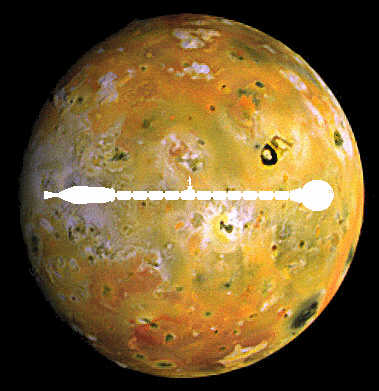 Okay - before you say anything, I know that this 360-frame animated
gif leaves quite a bit to be desired. The overall effect is somewhat
jittery, and there's an annoying flicker every time it "passes go" and the
sequence repeats.
Okay - before you say anything, I know that this 360-frame animated
gif leaves quite a bit to be desired. The overall effect is somewhat
jittery, and there's an annoying flicker every time it "passes go" and the
sequence repeats.

 Eighteen months later, a bigger expedition
is organized to visit Jupiter to see what's afoot.
Eighteen months later, a bigger expedition
is organized to visit Jupiter to see what's afoot.
 <= click
<= click

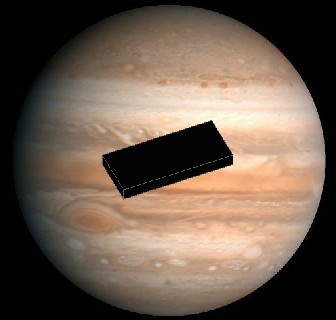 When Dave Bowman eventually reaches Jupiter, he finds a
much larger version
of the monolith (about two kilometres long) at the Lagrange point between
Jupiter and Io (mentioned above). He takes one of the two surviving space
pods out to investigate (HAL had used the third one to dispose of Poole
earlier) - and his last message to the very worried mission controllers
back on Earth is:
When Dave Bowman eventually reaches Jupiter, he finds a
much larger version
of the monolith (about two kilometres long) at the Lagrange point between
Jupiter and Io (mentioned above). He takes one of the two surviving space
pods out to investigate (HAL had used the third one to dispose of Poole
earlier) - and his last message to the very worried mission controllers
back on Earth is:
full of stars... ”
another NASA public-domain picture; click
here
to see it.
 ]
]


- EXCEPT EUROPA.
ATTEMPT NO LANDINGS THERE.




 ).
).
http://www.examiner.com.au/news/local/news/politics/
taxpayers-foot-300000-hydro-legal-bill/2012701.aspx
 )
)

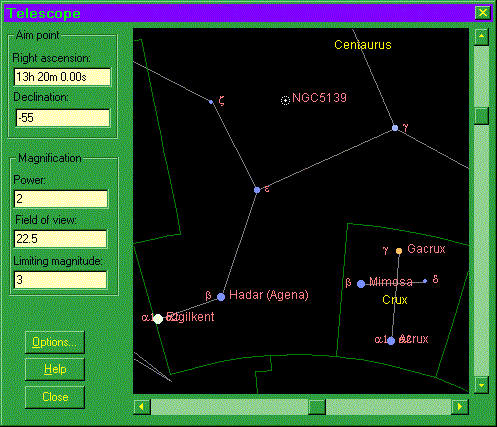
This graphic has appeared earlier in this site, in my
Distances in space
page. It's a screen-shot of an image produced using the excellent freeware
planetarium program
Home Planet.

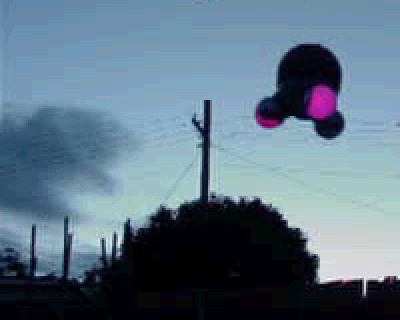 The launch is set to occur in a secret location in Siberia, away from
prying eyes. Right on cue and without any hitches, the good ship
SETI-1 lifts off into the evening sky and sets course for our
nearest stellar neighbour.
The launch is set to occur in a secret location in Siberia, away from
prying eyes. Right on cue and without any hitches, the good ship
SETI-1 lifts off into the evening sky and sets course for our
nearest stellar neighbour.
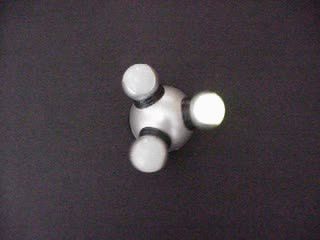 So - our intrepid band of explorers is on its way. Because it's going
to be a long trip (even at the relativistic speeds achievable by the WINCH
drive), they're all in hibernation. The ship's friendly computer, PAL (who
knows the purpose of the mission - and, more importantly, knows that all
the crew members also know, and can thus be trusted to be reliable),
has instructions to revive them in plenty of time to prepare for the
exciting work ahead.
So - our intrepid band of explorers is on its way. Because it's going
to be a long trip (even at the relativistic speeds achievable by the WINCH
drive), they're all in hibernation. The ship's friendly computer, PAL (who
knows the purpose of the mission - and, more importantly, knows that all
the crew members also know, and can thus be trusted to be reliable),
has instructions to revive them in plenty of time to prepare for the
exciting work ahead.

The VHF signals are being beamed from this object toward the planet.
However, the ship's company soon establish that, owing to atmospheric
refraction and reflection, a proportion of the signal leaks past the planet
and into deep space - some of it finding its way to Earth, depending on the
juxtaposition of the relevant bodies at a particular time - essentially,
the "time of year" for the planet. Knowing this, however, doesn't make any
clearer why the object is broadcasting at all - let alone relaying
low-quality Earthling TV-shows to an alien world.
 It turns out that, on the "day-side", the planet has a breathable
oxygen-nitrogen atmosphere, indicating the presence of plant life. Indeed,
there is reasonably lush vegetation in the
"warm zone" centre of the "day-side", gradually
thinning out to a low-level coverage of small, bluish-green grassy plants
over the "cool zone". Then there is a narrow
"cold zone", where almost nothing will grow,
extending to the terminator. Some large lakes in the "warm zone", fed by
"cool zone" rivers, ensure that the plant-life can survive and do reasonably
well from the occasional rains.
It turns out that, on the "day-side", the planet has a breathable
oxygen-nitrogen atmosphere, indicating the presence of plant life. Indeed,
there is reasonably lush vegetation in the
"warm zone" centre of the "day-side", gradually
thinning out to a low-level coverage of small, bluish-green grassy plants
over the "cool zone". Then there is a narrow
"cold zone", where almost nothing will grow,
extending to the terminator. Some large lakes in the "warm zone", fed by
"cool zone" rivers, ensure that the plant-life can survive and do reasonably
well from the occasional rains.

•
This carefully-doctored photo added on Friday, 29th September 2011  •
•
 This dimly-lit area (within which the "sun" is always at about
60o from the
zenith)
has a dense covering of large pinkish-grey mushroom-like fungoids growing
within it - far more than would be expected, given the dryness of the
climate in these parts. Deciding to have a closer look at the strange
object in the sky, to see if it offers any clues, they take off and head
back toward L4.
This dimly-lit area (within which the "sun" is always at about
60o from the
zenith)
has a dense covering of large pinkish-grey mushroom-like fungoids growing
within it - far more than would be expected, given the dryness of the
climate in these parts. Deciding to have a closer look at the strange
object in the sky, to see if it offers any clues, they take off and head
back toward L4.

WE WILL STOP THE BOATS
WE WILL STOP THE BOATS

MY GOD - IT'S FULL OF


But the story doesn't end there. Just like Jim, the Waco Kid, in
Blazing Saddles,


